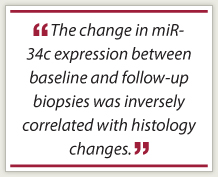MiRNAs, negative post-transcriptional regulators of gene expression, are involved in bronchial carcinogenesis from the very early steps of this process. Endobronchial histology is currently considered as the best intermediate endpoint for chemoprevention studies. However, no intermediate biomarker has been validated for the prevention of lung cancer.
 While histologic grading is reproducible between specialized pathologists, more quantitative biomarkers of response are desirable. Therefore, a group of researchers analyzed the expression of selected miRNA as potential surrogate biomarkers in the iloprost (Ventavis, a synthetic analog of prostacyclin) phase II, placebo-controlled multicenter lung cancer chemoprevention trial. The phase II trial is the first to meet a predetermined primary endpoint of histology improvement.1 Results were presented recently by Celine Mascaux, MD, PhD, Assistant Research Professor and Medical Oncologist at the University of Colorado Cancer Center, at the 3rd European Lung Cancer Conference in Geneva, Switzerland.
While histologic grading is reproducible between specialized pathologists, more quantitative biomarkers of response are desirable. Therefore, a group of researchers analyzed the expression of selected miRNA as potential surrogate biomarkers in the iloprost (Ventavis, a synthetic analog of prostacyclin) phase II, placebo-controlled multicenter lung cancer chemoprevention trial. The phase II trial is the first to meet a predetermined primary endpoint of histology improvement.1 Results were presented recently by Celine Mascaux, MD, PhD, Assistant Research Professor and Medical Oncologist at the University of Colorado Cancer Center, at the 3rd European Lung Cancer Conference in Geneva, Switzerland.
Lung Inflammation
The miRNA’s role in lung inflammation can be described as follows:
- Gene-expression profiles during successive steps of lung carcinogenesis have an important role in immune and inflammatory pathways when comparing low-grade and high-grade lesions.
- MiRNAs were shown to be upregulated in vivo following lung lipopolysaccharide-induced inflammation.
- MiRNAs are modulated in vivo following lung inflammation’s induction, and many reports showed miRNA expression involvement in immunity, and in the progression of chronic inflammatory lung disease.
Biopsies at Baseline and after Chemoprevention
Dr. Mascaux and colleagues hypothesized that miRNAs could be both potential surrogate endpoints and predictive biomarkers for chemoprevention trials. They tested this hypothesis in the iloprost chemoprevention trial, and in particular association of miRNA expression with histology, tobacco status, treatment effect, and prediction of response to treatment.
Matched biopsies at baseline and the same site at follow-up after 6 months of iloprost or placebo were obtained in 125 high-risk individuals who completed the iloprost trial: 40 current smokers and 35 former smokers were in the iloprost arm, and 25 current smokers and 25 former smokers were in the placebo arm. The researchers planned to analyze 500 biopsies but identified 496 biopsies with appropriate tissue. The plan was to obtain four matched biopsy pairs per patient: the best and the worst histology at baseline, and the two biopsies from the same site at follow-up. For every biopsy, total RNA was extracted from eight cuts of formalin-fixed, paraffin-embedded sections adjacent to the diagnostic section. Criteria for miRNA to be tested were selection from the list of 69 miRNAs identified in bronchial human biopsies as being differentially expressed during lung squamous carcinogenesis. Fourteen selected miRNAs previously identified in high-grade bronchial preneoplasia were analyzed by quantitative reverse-transcriptase polymerase chain reaction assay.
MiR-34c Expression and Histologic Response
 In the earlier and current studies, miR-34c expression was inversely correlated with baseline histology grade (P < .001). The current study demonstrated that the change in miR-34c expression between baseline and follow-up biopsies was also inversely correlated with histology changes (P = .0003), and this was independent of the treatment arm or smoking status. In addition, a lower miR-34c expression at baseline, and consequently its increase at follow-up, was significantly associated with histologic response in the iloprost (P =.0022) and placebo arms (P = .0025).
In the earlier and current studies, miR-34c expression was inversely correlated with baseline histology grade (P < .001). The current study demonstrated that the change in miR-34c expression between baseline and follow-up biopsies was also inversely correlated with histology changes (P = .0003), and this was independent of the treatment arm or smoking status. In addition, a lower miR-34c expression at baseline, and consequently its increase at follow-up, was significantly associated with histologic response in the iloprost (P =.0022) and placebo arms (P = .0025).
MiR-34c is a transcriptional target of p53, which is upregulated in lung formation, but downregulated during the whole process of carcinogenesis. In this analysis, the authors showed that the change in miR-34c expression between baseline and follow-up biopsies was inversely correlated with histology changes, and this was independent of the treatment arm or smoking status. Thus, miR-34c expression is a good reflection of baseline histology and histology changes. In responders, the miR-34c expression is significantly lower at baseline and increased at follow-up, related with a worse histology at baseline and its downgrading at follow-up. Therefore, the researchers concluded that the change in miR-34c expression in follow-up biopsies is correlated with histologic response and may be a quantitative biomarker of response in lung chemoprevention studies. ■
Disclosure: Dr. Mascaux reported no potential conflicts of interest.
Reference
1. Mascaux C, Keith RL, Feser WJ, et al: MIR-34C is a potential biomarker for histological response in lung cancer chemoprevention studies. European Lung Cancer Conference. Abstract 65O. Presented April 19, 2012.

